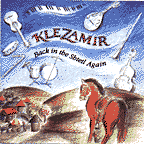Klezamir / Back in the Shtetl Again

Klezamir
Back in the Shtetl Again
KL102, 1998
CD/MP3s available from the band website.
One of the things that I enjoy most about being in New England is the wonderful way so many folk traditions are so actively supported, often by the same neat people. One can, for instance--as happened to me just a few weeks ago--attend a Balkan Dance party in a small town in New Hampshire and run into one of one's favorite local klezmer bands, Klezamir, doing a quick set between the Macedonian strings and the Serbian oompa band (or local equivalents thereof) for a quick refresher in Israeli dance. Life is good here in New England.
If Klezamir's first album was tasty, this new one is even more so, and nicely reflects a diversity and a growing fusion between Klezmer and Yiddish roots, and more modern American country roots. This is especially evident in the band's swing version of "Tumba," and in case one misses the point, mandolinist Jim Armenti's "Saltarelli Waltz," immediately following drives the idea home. (Armenti's country band is well-known and well-liked in these parts.) Most listeners will have already caught on to the idea in the earlier, delicious bluegrass-klezmer fusion of the "Noshville Bulgar" where the bluegrass picking flows in and out with Amy Rose's more traditional bulgarish flute.
I will admit that I was momentarily taken aback by the album's cheerful, throaty opener, an upbeat, sinfully joyous "Vos Vet Zayn," a hasidic chant that I usually hear in my head through the filter of the Flying Bulgars' amazing dronish chant of same, complete with dumbeks and Canadian Yiddish humorist Michael Wex's surreal Yinglish chanting. But, I can handle change. And some things on this album don't change at all. Just to prove that they can do traditional wedding entertainment, there are a few spots just so on the disk--a medley of freylekhs in the middle, for instance, featuring Armenti on clarinet (and Bernard's scat, Rose's piano, and lots of whistling and bird chirps), or the earlier Doina-hora-sirba led, this time, by Amy's ergonomic flute. I'm less fond of the band's "Miserlu," and I wouldn't have felt that "Romania, Romania" needed to be recorded yet again (although, again, I do enjoy the country-ish touches).
[Skip this paragraph if complaints about the liner notes seem too petty.] If I have any complaint, it is the use of upper case letters to represent the Yiddish transliteration in the liner booklet. In a nutshell, people cannot read capital letters easily. It's bad enough that transliteration is most often presented in italic (usually less readable than the more usual roman text face), but ALL CAPS is a no no. (This applies to song titles, as well). There are virtually no places in standard English usage where readability matters that ALL CAPS are acceptable. (This typographer wouldn't mind standing a few street sign frauds, and the town councils that hired them, up against a wall and ... well, let's return to klez.) Better typographic solutions for Yiddish lyrics include use of two separate columns, use of italic, and/or two different typefaces to differentiate translation from transliteration. It's nice that the lyrics and transliteration are there. It matters. I get carried away because the effort having been conscientiously made, it should actually be of help to the album's listeners. An excellent example of Yiddish translation, transliteration, and even the Yiddish, itself, was demonstrated in the booklet from the recent kids' album, Di Grine Katshke.
The album's near-closing numbers form a perfect set by which to remember this lovely return engagement. First "Dem Zeydns Nign" with lyrics by Soviet-era poet Shike Driz, set to music by Josh Waletzky, and then the delightful Bernard-Schrag medley, "Shtetl Strut/Geshtupte Freylekh," in which klezmer, folk, and "oriental" melodies mix into something new and special. I haven't had so much fun with "American" influences on a klezmer album since Finjan's "Crossing Selkirk Avenue" far too many years ago. In some ways, one wonders why one doesn't hear this sort of fusion more often. Now that the klezmer revival is nearly a generation past, perhaps more bands will quarrel less about what authentic Jewish music is, and do as Klezamir has done, and focus on playing music to which their audiences enjoy dancing. One hopes that the band continues to return to the shtetl time and time again, and that this fusion of klezmer, Yiddish, and good ol' American country continues to deepen and to grow.
Reviewed by Ari Davidow 6/22/98
Personnel this recording:
Joe Blumenthal: bass, nose flute, tenor banjo, back-up vocals
Jim Armenti: clarinet, acoustic and electric guitars, mandolin, back-up vocals
Keith Levreault: drum set, percussion
Rhoda Bernard: lead vocals, piano on #9
Amy Rose: flute, piano, back-up vocals
Songs
- Vos Vet Zayn—What will be (trad. Hasidic) 7:06
- Noshville Bulgar (trad./arr. Klezamir) 4:43
- Zog es mir nokh a mol--Tell me again (lyrics: Jacob Jacobs; music: Abraham Ellstein) 5:22
- Doina/Oriental Hora/Sirba (trad./arr. Klezamir) 5:46
- Tumba (trad.) 2:46
- Saltarelli Waltz (Jim Armenti) 4:18
- Yankl's Freylekh / Kammen Freylekh #1 / Varshever Freylekh (Jim Armenti/trad./trad.) 6:04
- Dem Zeydns Nign--Grandfather's Melody (lyrics: Shike Driz; music: Josh Waletzky) 4:35
- Shtetl Strut / Geshtupte Freylekh (Bernard & Schrag/Bernard) 6:53
- Miserlu (trad.) 5:55
- Rumenye, Rumenye (Aaron Lebedeff) 5:04

